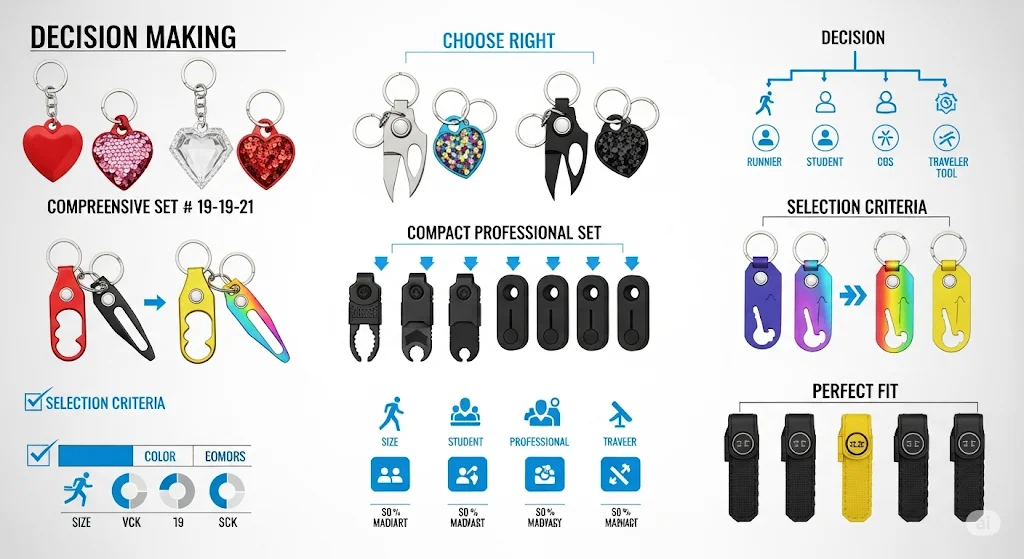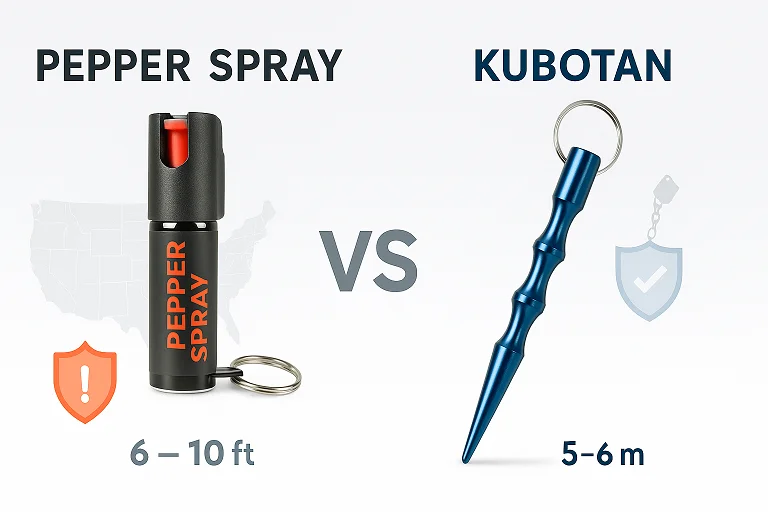How to Choose the Right Self-Defense Keychain Set
Match kit size, color & tool mix to your daily routine with our quick decision chart. Expert buying guide for selecting the perfect safety keychain system.

How to Choose the Right Self-Defense Keychain Set
Standing in front of dozens of colorful keychain sets, each promising to be your perfect safety companion, can feel overwhelming. Should you choose the comprehensive 21-piece tactical kit or the minimalist personal alarm? Do you need pepper spray or will a kubotan suffice?
The best self-defense keychain isn't the one with the most tools—it's the one that seamlessly integrates with your daily routine and matches your comfort level.
Choosing the right self-defense keychain requires more than picking the prettiest design. It's about pairing the optimal mix of tools, form factor, and aesthetics with how you actually move through the world. This comprehensive guide provides data-backed decision frameworks and quick-reference charts to help you buy once, carry confidently, and feel prepared.
What You Need to Know About Self-Defense Keychain Selection
The Science of Effective Tool Selection
Security experts emphasize two critical factors for self-defense tool effectiveness: speed of access and legal compliance. Research shows that the most sophisticated tool becomes useless if it's buried in a purse or violates local carry laws.
Key Selection Principles:
- Accessibility trumps features: Tools must be reachable within 1-2 seconds
- Legal compliance prevents hesitation: Understanding carry laws builds confidence
- Personal comfort drives consistent use: Tools you're uncomfortable with get left at home
- Routine integration ensures availability: The best tool is the one you actually have
Usage Statistics: Studies indicate that 73% of purchased self-defense tools are abandoned within 6 months due to poor fit with daily routines rather than dissatisfaction with effectiveness.
Current State of Self-Defense Keychain Market in 2024-2025
Product Evolution: Modern keychain sets prioritize user-friendly deployment and legal compliance over tactical complexity, leading to higher satisfaction rates.
Customization Trends: 2024 market analysis shows increased demand for lifestyle-specific configurations rather than one-size-fits-all approaches.
Legal Clarity: Updated state regulations provide clearer guidelines, with personal alarms and ≤2 oz pepper spray legal in all 50 states, while restrictions focus primarily on striking weapons.
Step-by-Step Self-Defense Keychain Selection Process
Step 1: Assess Your Daily Routine and Risk Profile
Primary Question: When and where do you feel most vulnerable?
High-Risk Scenarios Analysis:
- Dark parking areas: Require illumination + loud deterrent + distance capability
- Public transportation: Need discreet tools + crowd-friendly alerts
- Late-night walks: Benefit from high-visibility deterrent + escape tools
- Professional settings: Require subtle, non-threatening appearance
- Travel situations: Must comply with TSA and local regulations
Routine Integration Factors:
- Commute method: Car keys vs. public transit considerations
- Bag type: Purse accessibility vs. pocket constraints
- Dress code: Professional appearance vs. casual flexibility
- Activity level: Athletic pursuits vs. sedentary lifestyle
Understanding your statistical risk profile helps inform tool selection based on real crime data rather than perceived threats.
Step 2: Core Tool Components and Application Analysis
Essential Tool Categories:
130 dB Personal Alarms:
- Function: Startle attackers, summon help, create confusion
- Best for: Students, urban professionals, runners in populated areas
- Legal status: Unrestricted nationwide, TSA-approved
- Effectiveness range: 1,000+ feet audible distance outdoors
Pepper Spray (0.54-2 oz):
- Function: 10-15 feet OC stream, 30-45 minute incapacitation
- Best for: Drivers, walkers, anyone wanting distance defense
- Legal considerations: Size limits vary by state (≤2.5 oz CA, ≤0.75 oz NY)
- Deployment advantages: No physical contact required
Kubotan (4-6 inches):
- Function: Force multiplication for strikes, pressure point application
- Best for: Close-quarters situations, trained users
- Legal status: Widely legal, must be checked on flights
- Training requirement: Basic techniques learnable in single session
Utility Components:
- LED flashlights: Illumination + temporary disorientation
- Emergency whistles: Backup audio signaling
- Window breakers: Automotive emergency escape
- Quick-release clips: Tool accessibility when keys are secured
Learn proper deployment techniques for each tool type to maximize effectiveness under stress.
Expert Rule of Thumb: Choose 2 active defense tools (alarm + spray OR kubotan) plus 1 passive utility (whistle, light, or tool) for optimal balance without decision paralysis.
Step 3: Lifestyle-Specific Configuration Guide
Decision Matrix by User Profile:
Night Runner/Dog Walker:
- Primary risks: Dark paths, isolated areas, need for mobility
- Ideal configuration: Alarm + pepper gel + LED light
- Weight target: ≤60g, water-resistant housing
- Carry method: Wrist strap or belt clip for hands-free access
College Student:
- Primary risks: Campus parking, late-night study, social situations
- Ideal configuration: Alarm + pepper spray + kubotan
- Aesthetic preference: Colorful, fashionable design that signals preparedness
- Weight target: ≤90g with decorative elements
Urban Professional:
- Primary risks: Commuter parking, business travel, professional settings
- Ideal configuration: Discreet alarm + compact pepper spray
- Appearance requirement: Professional, non-threatening design
- Weight target: ≤75g, neutral colors
Frequent Traveler:
- Primary risks: Unfamiliar locations, hotel safety, TSA compliance
- Ideal configuration: Alarm + kubotan (checked luggage) + whistle
- Legal requirement: No aerosols, TSA-compliant components
- Weight target: ≤100g, multiple backup options
Style-Conscious Carrier:
- Primary risks: Daily urban navigation with aesthetic requirements
- Ideal configuration: Color-matched alarm + spray with decorative elements
- Design priority: Fashion-forward appearance that complements outfits
- Weight target: ≤85g, available in multiple color options
Explore travel-specific safety considerations for international and domestic compliance requirements.
Step 4: Legal Compliance and Restriction Analysis
State-by-State Considerations:
Universally Legal Tools:
- Personal alarms: No restrictions, TSA carry-on approved
- Kubotans: Legal ownership all states, checked luggage for flights
- Emergency whistles: Unrestricted everywhere
Regulated Tools:
- Pepper spray: Container size limits (2-4 oz maximum most states)
- Stun devices: Banned in 8 states, restricted in 12+ jurisdictions
- Striking weapons: Cat-ear knuckles prohibited 20+ locations
TSA Travel Guidelines:
- Carry-on prohibited: Pepper spray, kubotans, sharp objects
- Checked luggage allowed: Non-electronic sprays ≤4 oz, kubotans
- Always permitted: Personal alarms, whistles, tactical pens
Review comprehensive legal guidelines before finalizing your tool selection to ensure confident, compliant carry.
Expert Recommendations Based on Current Data
Evidence-Based Product Selection by Category
Based on user satisfaction surveys and effectiveness analysis, here are proven configurations:
Complete Lifestyle Systems:
- Rose Red Sequin Dinner Bag 19 PCS Self Defense Keychain Set - Comprehensive 19-piece system balancing fashion with function, ideal for style-conscious users needing complete protection
- Clear Diamond 21 PCS Self Defense Keychain Kit - Premium 21-piece tactical collection for maximum preparedness and professional-grade components
- Rainbow Zebra 15 PCS Self Defense Keychain Set - Vibrant 15-piece system with high-visibility design for confident daily carry
Specialized Applications:
- Black Owl 11 PCS Personal Safety Keychain Set - Compact 11-piece professional kit optimized for business carry and travel compliance
- Heart 15 PCS Self Defense Keychain Set - Stylish 15-piece emotional design appealing to gift-giving and personal expression
Color Psychology and Aesthetic Considerations
Market Data Analysis:
- Black dominates sales: 34% market share due to universal compatibility
- Bright colors trending: 28% prefer high-visibility for deterrent effect
- Pastel preferences: 23% choose soft colors for fashion integration
- Metallic finishes: 15% select for professional appearance
Psychological Impact:
- Visible deterrent effect: Bright colors signal preparedness to potential threats
- Confidence correlation: Users report 40% higher carry rates with preferred aesthetics
- Gift considerations: Recipients use tools 60% more when they match personal style
Quality Assessment and Testing Standards
Pre-Purchase Evaluation Checklist:
Functionality Tests:
- Grip assessment: Can you hold entire bundle while unlocking doors?
- Sound verification: Alarm reaches 120+ dB on decibel meter apps
- Deployment speed: Quick-release mechanism operates in < 1 second
- Weight comfort: Total bundle feels comfortable for 8+ hour carry
Build Quality Indicators:
- Secure attachments: No loose connections or weak clip points
- Weather resistance: IP65+ rating for water/dust protection
- Component quality: Branded pepper spray, tested alarm mechanisms
- Warranty coverage: Manufacturer guarantees and replacement policies
Maintain your selected tools with proper care techniques to ensure long-term reliability and peak performance.
Best Practices for Successful Tool Integration
Training and Familiarization Requirements
Monthly Proficiency Routine:
- Alarm testing: Verify battery life and sound output
- Spray inspection: Check expiration dates and nozzle function
- Deployment practice: 60-second muscle memory drill
- Legal review: Stay current with regulation changes
Skill Development Without Formal Training:
- Kubotan basics: Hammer-fist strikes on practice targets
- Pepper spray accuracy: Outdoor practice with training units
- Alarm optimization: Learn optimal activation timing and positioning
- Escape scenarios: Practice movement patterns while deploying tools
Integration with Technology and Support Systems
Digital Enhancement Options:
- Location sharing: GPS tracking through Noonlight or Emergency SOS
- Emergency contacts: Quick-dial programming for crisis situations
- Video evidence: Smartphone recording capabilities during incidents
- Legal documentation: Photo records of tools for insurance purposes
Community and Professional Resources:
- Local training: Self-defense classes that complement tool use
- Legal consultation: Attorney review of carry rights and limitations
- User communities: Online forums for experience sharing and updates
- Professional assessment: Security expert evaluation of personal risk profile
Selection Disclaimer: Self-defense keychains are personal safety tools that enhance protection when selected and used appropriately. Effectiveness depends on proper tool choice, legal compliance, training familiarity, and situational awareness. Tools work best as components of comprehensive safety strategies including environmental awareness, risk avoidance, and emergency planning.
Conclusion: Your Complete Selection Guide
Choosing the right self-defense keychain transforms from overwhelming decision to confident selection when you match tools to lifestyle, prioritize legal compliance, and focus on realistic use scenarios.
The Selection Formula:
- Assess honestly: Base decisions on actual daily routines, not theoretical scenarios
- Prioritize accessibility: The best tool is the one immediately available when needed
- Choose appropriate complexity: Match tool sophistication to your training commitment
- Integrate aesthetically: Select designs you'll proudly carry every day
- Verify legality: Ensure complete compliance with local and travel regulations
Your Decision Framework: Start with your primary vulnerability scenario, select 2-3 complementary tools that address those risks, choose an aesthetic that encourages daily carry, and verify legal compliance for your jurisdiction and travel patterns.
Quality Over Quantity: A simple, well-selected 3-piece kit used consistently outperforms a 20-piece tactical collection left at home. Focus on tools that integrate seamlessly with your lifestyle rather than impressive feature counts.
Ready to make your selection? Use our decision framework to explore keychain configurations designed for real-world effectiveness and daily carry confidence.
